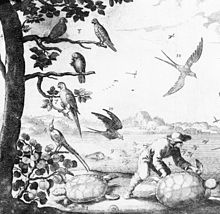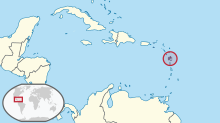| WikiProject WikiFundi Content/Lesser Antillean macaw | |
|---|---|

| |
| Du Tertre's 1667 illustration showing three Guadeloupe amazons (8) and one Lesser Antillean macaw (7) on a tree at the left | |
| Scientific classification | |
| Domain: | Eukaryota |
| Kingdom: | Animalia |
| Phylum: | Chordata |
| Class: | Aves |
| Order: | Psittaciformes |
| Family: | Psittacidae |
| Subfamily: | Arinae |
| Tribe: | Arini |
| Genus: | Ara |
| Species: | †A. guadeloupensis
|
| Binomial name | |
| †Ara guadeloupensis (Clark, 1905)
| |

| |
| Location of the Guadeloupe region | |
The Lesser Antillean macaw or Guadeloupe macaw (Ara guadeloupensis) is a hypothetical extinct species of macaw that is thought to have been endemic to the Lesser Antillean island region of Guadeloupe. In spite of the absence of conserved specimens, many details about the Lesser Antillean macaw are known from several contemporary accounts, and the bird is the subject of some illustrations. Austin Hobart Clark described the species on the basis of these accounts in 1905. Due to the lack of physical remains, and the possibility that sightings were of macaws from the South American mainland, doubts have been raised about the existence of this species. A phalanx bone from the island of Marie-Galante confirmed the existence of a similar-sized macaw inhabiting the region prior to the arrival of humans, and was correlated with the Lesser Antillean macaw in 2015. Later that year, historical sources distinguishing between the red macaws of Guadeloupe and the scarlet macaw (A. macao) of the mainland were identified, further supporting its validity.
According to contemporary descriptions, the body of the Lesser Antillean macaw was red and the wings were red, blue and yellow. The tail feathers were between 38 and 51 cm (15 and 20 in) long. Apart from the smaller size and the all-red coloration of the tail feathers, it resembled the scarlet macaw and may therefore have been a close relative of that species. The bird ate fruit – including the poisonous manchineel, was monogamous, nested in trees and laid two eggs once or twice a year. Early writers described it as being abundant in Guadeloupe, but it was becoming rare by 1760, and only survived in uninhabited areas. Disease and hunting by humans are thought to have eradicated it shortly afterwards. The Lesser Antillean macaw is one of 13 extinct macaw species that have been proposed to have lived in the Caribbean islands. Many of these species are now considered dubious because only three are known from physical remains, and there are no extant endemic macaws on the islands today.